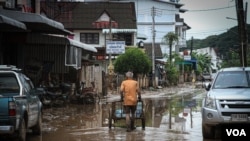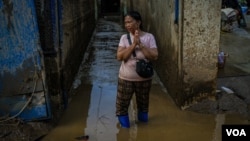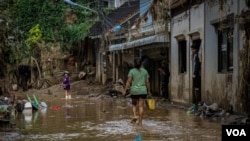The severe and prolonged flooding that has deluged Thailand is devastating hundreds of thousands of residents and prompting calls for long-term solutions, including measures to mitigate the long-term impact of climate change.
Thailand suffers from an annual monsoon season from July to October. Although floods are common nationwide, authorities say this year has been the worst in decades.
Thanapon Piman, senior research fellow, SEI Asia Center, says climate change has contributed to the flooding.
“Climate change and La Niña ... cause heavy rainfall over the region more than normal condition. For example, the monthly rainfall in Chiang Rai in August is higher [than] normal [by] 40% to 50%. Mae Sai has faced flooding six times in a month, which never happened before,” he told VOA.
The La Niña phenomenon is the natural cooling of the water in the central and eastern Pacific Ocean. It occurs every few years and affects weather worldwide.
Thanapon said authorities knew La Niña would make this season wetter than normal, but not that it would be so extreme. “This is certainly caused by climate changes.”
The floods were exacerbated by Typhoon Yagi, which rampaged through Thailand and other Southeast Asian countries in mid-September. Upwards of 150,000 families have been affected by the floods in Thailand, with 46 killed, according to Disaster Prevention and Mitigation Department.
“It triggered severe flash floods and mudslides over the north region. As the result of heavy rainfall since August, land turned into saturated soil. Thus, when the heavy rainfall from the Yagi Typhoon hit the region, it caused the extreme flooding,” Thanapon said.
"Flooding and extreme events happen [not] only [in] Thailand but also happen in Vietnam, the Philippines, Laos and Myanmar.”
In Chiang Mai, the second largest city in Thailand, floods have intensified in recent days. Direct daily train service between Bangkok and Chiang Mai was temporarily affected by a landslide, while roads were flooded.
In Chiang Rai itself, the flooding has been a problem for weeks, with at least 1,268 families affected. Residents told VOA that the floods were waist-deep and even though they have subsided, foot-deep water remains in the streets while buildings are clogged with sludgy mud.
Chalermpon “Por” Thungkham owns a congee restaurant in Chiang Rai with his mother and father. He says the floods have ruined his home and business.
“The stuff for the food to prepare got damaged, the electricity got cut, everything is ruined inside. It was like this for three days until it got back to ‘normal,’ but then there was the mud. We wanted to clean the mud, but we didn’t have the water supply,” he told VOA.
He said his breakfast shop usually brings in around $30 per day, but the damage to his facilities is equal to a year’s worth of income. His family has been relying on aid trucks to bring everyday supplies.
“The flooding has caused more than maybe 300,000 THB ($9,168) of damage. The car, the furniture we need to fix. It will take one month to clean and re-open the restaurant,” he added.
Fifty miles north in Mae Sai, on the border with Myanmar, relatives of the city’s residents have come from around the country to help repair and clean up ruined homes. One of those is Sky, a hairdresser who works in Bangkok.
“I came back to Chiang Rai because I was worried about my mother and child who were trapped in our house for three days during the flooding,” she told VOA. “We still have mud on both sides of the house, and there is still mud in the kitchen and bathroom that needs to be cleaned. We have to wait for clean water.”
The Wat Tham Pha Chom Buddhist Temple has become a makeshift shelter for hundreds of residents in Mae Sai. Situated on a hill, the religious sanctuary has been largely unaffected by the floods.
“After the big flooding, the people came to stay here,” said Phra Manatcha Pothisam, a monk and acting director of Wat Tham Pha Chom, who spoke to VOA amid stacked water containers and piles of second-hand clothes for those in need.
“There was around 300 people, men and women are separated, but we provide food for meals, drinking water, and some clothes. This is from donations and government subsidies. Right now there are 150 people live here,” he said.
“Many of the villagers were very scared. This temple is the place for meditation [and] has been supported by the people, so we need to give back.”
Paetongtarn Shinawatra, who became Thailand’s 31st prime minister in August, has said the government’s top priority is addressing the flooding, and called for the mud to be cleared in Chiang Rai promptly.
Economically, the floods could cause Thailand up to $176 million in damages, Thailand’s Chamber of Commerce has estimated.
But Arisara Lekkham, a lecturer at the School of Law at the Mae Fah Luang University in Chiang Rai insists Thailand needs a long-term plan to combat the flooding.
“Flood management should become a regular, year-round effort rather than a reactive, seasonal approach,” she told VOA.
“Many houses are damaged, and it will take months before people can return to their homes. It is proposed that the government implement additional relief measures for the affected people. The lessons learned from the Chiang Rai floods should be applied to other areas currently facing flood problems, especially regarding early warning systems," she added.












